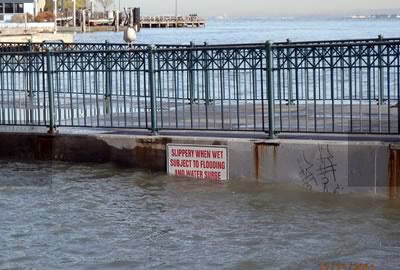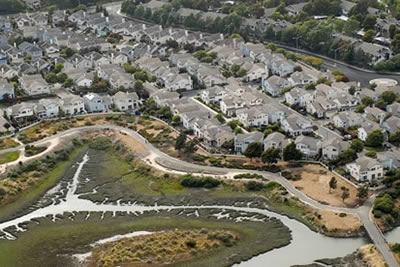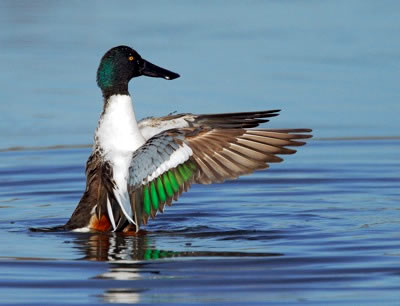Issues Click headers below to expand
Climate Change

Photo courtesy of the California King Tides Initiative
What you may not know
- Healthy, restored wetlands can protect our communities from flooding due to sea level rise and extreme storms during high tides.
- Wetlands serve as buffers between open bay waters and our homes, roads and businesses.
- Wetland restoration offers a natural defense against sea level rise which is already occurring. Scientists predict an additional two-foot rise in sea level over the next 40 years.
- The sooner we restore wetlands, the sooner they will establish themselves and absorb increasing water levels.
- Restoring wetlands is a cost-effective way to create resilient coastal and Bay Area communities.
- Wetlands are important to wildlife and people
- Many species of wildlife including both common and endangered birds, fish, and mammals need wetlands to survive. This includes the California Clapper Rail, salt marsh harvest mouse, herring, salmon, steelhead, and anchovy.
- Healthy wetlands filter pollution out of the water that drains from our streets and neighborhoods. Healthy wetlands also protect our homes and roads against storms, provide a nursery for young fish, and are places where many of the 7 million people in the Bay Area hike, bike, and watch wildlife.
- Healthy wetlands take in excess carbon from the atmosphere, helping to reduce future climate change impacts.
- Wildlife need habitat now—and into the future.
- Restoring wetlands now will help plants and animals survive as the climate changes and sea levels rise.
What you can do

Stege Marsh, Berkeley
- Give money to organizations that are restoring wetlands! Find links on our Support page
- In 2014, vote to support a ballot measure that will directly fund bay area wetland restoration and science.
- Write your representatives and ask that they support the San Francisco Bay Restoration Act!
- For news, updates and links to a variety of Bay Area climate smart efforts visit the Bay Area Ecosystems Climate Change Consortium
- If you want to get involved in a citizen based effort to document the impacts of rising waters on the California coasts check out the California King Tides Initiative.
State of the Birds
How are birds doing in the Bay Area?
Modeled after the National State of the Birds report in 2011 PRBO Conservation Science and the San Francisco Bay Joint Venture produced the first-ever State of the Birds Report for San Francisco Bay. Organized by habitat type and endangered species, the report is a summary of the current state of knowledge on SF Bay's bird populations. With compiled data from 29 leading Bay Area scientists, it details actions needed to keep birds and their habitats thriving as sea levels rise and extreme storm events increase due to global climate change.
The messages delivered through the report aim to enhance bird conservation in San Francisco Bay by:
- Guiding habitat restoration, management, and acquisition;
- Increasing knowledge of the population status of San Francisco Bay's birds and the threats to their habitats; and
- Influencing public policy and public awareness of bird and ecosystem conservation needs.
Human Disturbance

Northern Shoveler – Tom Grey
Human Disturbance and Waterfowl
A Review of Human Disturbance Impacts on Waterbirds [104 KB PDF]
According to a 2009 Fish and Wildlife Service report, 1 out of 5 American's watches birds and in a 2006 study, birdwatchers contributed 36 million to the U.S. economy. This is great news for birds and people!! Connecting with nature and particularly birds fosters an ethic of caring and an enhanced quality of life for those who awaken to the wonders of bird behavior, diversity and beauty.
Similarly, waterfowl hunters represented by groups such as Ducks Unlimited and State agencies like the Department of Fish and Wildlife (formerly Dept of Fish and Game) contribute greatly to the conservation and protection of habitat these birds need to thrive.
How we go about enjoying birds can also unknowingly present threats to bird survival. Several studies have been done showing conflicts between waterbirds and recreationists resulting in human-caused disturbances that alter bird behaviors, diverting time and energy away from other more essential behaviors.
Simply observing temporary or trail seasonal closures, keeping pets on leashes, and maintaining usually a 250 m distance from nesting sites, especially in boats without motors are a few ways you can help minimize human caused impacts to birds.
